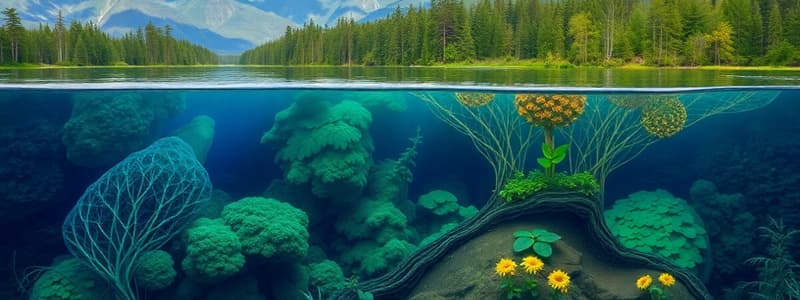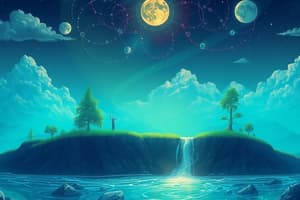Podcast
Questions and Answers
Which of the following best describes an abiotic component of an ecosystem?
Which of the following best describes an abiotic component of an ecosystem?
- The various species of fish in a lake.
- The amount of sunlight available to plants in a meadow. (correct)
- A community of bacteria living in the soil.
- A population of deer in a forest.
What is the primary role of photosynthesis in the carbon cycle?
What is the primary role of photosynthesis in the carbon cycle?
- Converting gaseous carbon compounds into nongaseous compounds. (correct)
- Facilitating cellular respiration in plants.
- Releasing carbon dioxide into the atmosphere.
- Decomposing organic matter to release carbon into the soil.
Which reservoir holds the largest amount of carbon?
Which reservoir holds the largest amount of carbon?
- Oceans
- Earth's Crust (correct)
- Fossil Fuels
- Atmosphere
How does deforestation primarily disrupt the local water cycle?
How does deforestation primarily disrupt the local water cycle?
Why is nitrogen often a limiting nutrient in ecosystems?
Why is nitrogen often a limiting nutrient in ecosystems?
Which of the following processes converts ammonium ($NH_4^+$) into nitrite ($NO_2^-$) and then into nitrate ($NO_3^-$)?
Which of the following processes converts ammonium ($NH_4^+$) into nitrite ($NO_2^-$) and then into nitrate ($NO_3^-$)?
Why is the use of fertilizers containing phosphorus associated with the phenomenon of algal blooms?
Why is the use of fertilizers containing phosphorus associated with the phenomenon of algal blooms?
According to the first law of thermodynamics, what happens to energy in a closed system?
According to the first law of thermodynamics, what happens to energy in a closed system?
What does the second law of thermodynamics imply about energy transfer in ecosystems?
What does the second law of thermodynamics imply about energy transfer in ecosystems?
Which of the following best describes the flow of energy in an open system like Earth?
Which of the following best describes the flow of energy in an open system like Earth?
How do chemoautotrophs obtain energy?
How do chemoautotrophs obtain energy?
Which of the following organisms occupies the first consumer level?
Which of the following organisms occupies the first consumer level?
In the context of trophic levels, what role do decomposers play?
In the context of trophic levels, what role do decomposers play?
What is a trophic cascade?
What is a trophic cascade?
Which term describes the rate at which organisms in a trophic level collectively synthesize new organic matter?
Which term describes the rate at which organisms in a trophic level collectively synthesize new organic matter?
How much of the solar energy captured by primary producers is generally available as chemical-bond energy to heterotrophs?
How much of the solar energy captured by primary producers is generally available as chemical-bond energy to heterotrophs?
What typically happens to the majority of energy that an organism ingests?
What typically happens to the majority of energy that an organism ingests?
Which type of ecosystem, measured by NPP per unit area, tends to be the most productive?
Which type of ecosystem, measured by NPP per unit area, tends to be the most productive?
In terms of energy flow through trophic levels, what is typically the limiting factor on the number of top carnivores an ecosystem can support?
In terms of energy flow through trophic levels, what is typically the limiting factor on the number of top carnivores an ecosystem can support?
Which ecological effect describes the impacts that flow down from upper to lower trophic levels?
Which ecological effect describes the impacts that flow down from upper to lower trophic levels?
Which of the following is an example of a 'bottom-up' effect in an ecosystem?
Which of the following is an example of a 'bottom-up' effect in an ecosystem?
In a simple three-level food chain consisting of plants, herbivores, and carnivores, what is the likely immediate effect of removing the carnivores?
In a simple three-level food chain consisting of plants, herbivores, and carnivores, what is the likely immediate effect of removing the carnivores?
Why are food webs more realistic representations of ecosystems than simple food chains?
Why are food webs more realistic representations of ecosystems than simple food chains?
The sea otter/sea urchin/kelp system along the coast of North America is a typical example of:
The sea otter/sea urchin/kelp system along the coast of North America is a typical example of:
How might species richness potentially influence ecosystem stability?
How might species richness potentially influence ecosystem stability?
What does the concept of 'redundancy' refer to in the context of an ecosystem?
What does the concept of 'redundancy' refer to in the context of an ecosystem?
Which of the following contributes to why life is sustained on Earth?
Which of the following contributes to why life is sustained on Earth?
What happens as energy flows through an ecosystem?
What happens as energy flows through an ecosystem?
Compared to the preindustrial era, what is the biggest difference in the nitrogen cycle of today?
Compared to the preindustrial era, what is the biggest difference in the nitrogen cycle of today?
About how much of the water in the atmosphere is transferred from the land to the sea?
About how much of the water in the atmosphere is transferred from the land to the sea?
From the image, what is the most available source of fresh water?
From the image, what is the most available source of fresh water?
What is the relationship between gross primary productivity (GPP) and net primary productivity (NPP)?
What is the relationship between gross primary productivity (GPP) and net primary productivity (NPP)?
The image of runoff caused by fertilizers leads to algal blooms. Why is this bad?
The image of runoff caused by fertilizers leads to algal blooms. Why is this bad?
Most life is contained within a small portion of earth. Considering the diameter is approximately 13,000 km, what is the approximate percentage of where life is located?
Most life is contained within a small portion of earth. Considering the diameter is approximately 13,000 km, what is the approximate percentage of where life is located?
What is the correlation between surface area and the availability of resources? The greater the surface area...
What is the correlation between surface area and the availability of resources? The greater the surface area...
Which of the following is NOT recycled throughout the biosphere?
Which of the following is NOT recycled throughout the biosphere?
Synthesis of new organic compounds from inorganic compounds is called _________.
Synthesis of new organic compounds from inorganic compounds is called _________.
About how much of the solar radiation that reaches the earth is used for photosynthesis?
About how much of the solar radiation that reaches the earth is used for photosynthesis?
Flashcards
Ecosystem
Ecosystem
All organisms in a place, plus the abiotic environment and their interactions.
Materials Flow
Materials Flow
The flow of chemicals (like carbon, nitrogen, and water) through an ecosystem.
Energy Flow
Energy Flow
The movement of energy through an ecosystem's trophic levels.
Carbon Fixation
Carbon Fixation
Signup and view all the flashcards
Cellular Respiration
Cellular Respiration
Signup and view all the flashcards
Carbon Reservoirs/Pools
Carbon Reservoirs/Pools
Signup and view all the flashcards
Carbon Flux
Carbon Flux
Signup and view all the flashcards
Aquifers
Aquifers
Signup and view all the flashcards
Nitrogen Fixation
Nitrogen Fixation
Signup and view all the flashcards
Nitrification
Nitrification
Signup and view all the flashcards
Denitrification
Denitrification
Signup and view all the flashcards
First Law of Thermodynamics
First Law of Thermodynamics
Signup and view all the flashcards
Second Law of Thermodynamics
Second Law of Thermodynamics
Signup and view all the flashcards
Open System
Open System
Signup and view all the flashcards
Trophic Levels
Trophic Levels
Signup and view all the flashcards
Autotrophs
Autotrophs
Signup and view all the flashcards
Photoautotrophs
Photoautotrophs
Signup and view all the flashcards
Heterotrophs
Heterotrophs
Signup and view all the flashcards
Herbivores
Herbivores
Signup and view all the flashcards
Primary Carnivores
Primary Carnivores
Signup and view all the flashcards
Secondary Carnivores
Secondary Carnivores
Signup and view all the flashcards
Detritivores
Detritivores
Signup and view all the flashcards
Trophic Cascade
Trophic Cascade
Signup and view all the flashcards
Productivity
Productivity
Signup and view all the flashcards
Primary Productivity
Primary Productivity
Signup and view all the flashcards
Gross Primary Productivity (GPP)
Gross Primary Productivity (GPP)
Signup and view all the flashcards
Net Primary Productivity (NPP)
Net Primary Productivity (NPP)
Signup and view all the flashcards
Secondary Productivity
Secondary Productivity
Signup and view all the flashcards
Top-Down Effects
Top-Down Effects
Signup and view all the flashcards
Bottom-Up Effects
Bottom-Up Effects
Signup and view all the flashcards
Study Notes
Ecosystems
- Includes all organisms in a specific location
- Includes the abiotic environment, and their interactions
Materials Flow
- Also known as biogeochemical cycles
- Chemicals move through the ecosystem, including carbon, nitrogen, and water
- Involves both biotic and abiotic processes
Energy Flow
- Governed by the laws of thermodynamics
- Involves producers and consumers at different trophic levels
Carbon Cycle
- Carbon is a major component of organisms
- Carbon Fixation: Metabolic reactions create non-gaseous compounds, such as photosynthesis, from gaseous ones
- Cellular respiration releases CO2
Carbon Reservoirs
- Carbon exists in reservoirs or pools and moves between them (flux)
- The graphic provided is from 2007, and in 2019 the average atmospheric CO2 was 410 ppm or 875 Petagrams
Water
- All life requires water
- Water accounts for over 60% of adult human body weight
- The amount of water influences nature and abundance of organisms
- Synthesized during cellular respiration and broken down during photosynthesis
- Exists as freshwater and saltwater
Water Cycling
- Includes precipitation to water (0.320) to ice (29.2), runoff (0.030) to oceans (1320)
Changes in Water Capacity & Flux
- Deforestation disrupts the local water cycle
- Surface modification causes water to drain as rain
- Aquifer use results in higher discharge
- Climate Change causes ice, glacier melt, temperature, and is also linked to evaporation
Groundwater
- Groundwater is found underground
- Aquifers- Permeable, underground layers of rock, sand, and gravel saturated with water
- 95% of fresh water used in the United States is from this import reservoir
Nitrogen Cycle
- Nitrogen is a component of all proteins and nucleic acids
- Usually the element in shortest supply
- Atmosphere is made up of 78% nitrogen
- Most plants and animals cannot use N2 (gas)
- Plants and animals instead use NH3 (ammonia) and NO3 (nitrate)
Nitrogen Fixation
- Synthesis of nitrogen-containing compounds from N2
- Nitrification: N2 converts to NH3 then to NO3
- Denitrification: NO3 converts to N2
- Microbes carry out both processes
- Nitrogenous wastes and fertilizers radically alter the global nitrogen cycle
- Humans have doubled the rate of transfer of N₂ in usable forms into soils and water
Phosphorus
- Required by all organisms
- Occurs in nucleic acids, membranes, and ATP
- Phosphorus has no significant gas form
- Exists as PO4 in ecosystems
- Plants and algae use free inorganic phosphorus
- Animals eat plants to obtain their phosphorus
Thermodynamics
- First Law of Thermodynamics: Energy is neither created nor destroyed; it changes forms and can take the form of light, chemical-bond energy, motion, and heat
- Second Law of Thermodynamics: Entropy measures disorder in a system and all systems increase in disorder over time, it takes energy to maintain order
- Earth is an open system, energy arrives to, and is released from, Earth
- Earths incoming and outgoing flows of radiant energy must be equal for global temperatures to stay constant
Incoming and Outgoing Energy
- Human activities may be changing the composition of the atmosphere
- Greenhouse effect: heat accumulating on Earth
Trophic Levels
- This is the level at which an organism "feeds"
- Autotrophs: Synthesize the organic compounds from inorganic
- Photo autotrophs: light as energy source
- Chemoautotrophs: energy from inorganic oxidation reactions (prokaryotic)
- Heterotrophs: Cannot synthesize organic compounds from inorganic precursors
- Animals that eat plants and other animals
Producers and Consumers
- Primary producers are autotrophs
- Consumers are heterotrophs
- Herbivores on the first consumer level
- Primary carnivores eat herbivores
- Secondary carnivores eat primary carnivores or herbivores
- Detritivores eat decaying matter, such as earthworms, millipedes, and flies
- Decomposers break down dead matter and include bacteria and fungi
Trophic Cascade
- Food web indirect interactions result in a change of population size in one level affecting others
Trophic Cascade: Food Web of Flathead Lake
- Emphasizing three of the trophic levels: piscivores, planktivores, and herbivores
- Altered by the introduction of nonnative fishes and an opossum shrimp, M. diluviana
Productivity
- The rate at which organisms in the trophic level collectively synthesize new organic matter
- Primary productivity the productivity of the primary produces
- Respiration is the rate at which primary producers break down organic compounds
- Gross Primary Productivity (GPP): the raw rate at which primary producers synthesize new organic matter
- Net Primary Productivity (NPP) GPP less the respiration of the primary producers
- Secondary Productivity: is the productivity of a heterotroph trophic level
Studying That Suits You
Use AI to generate personalized quizzes and flashcards to suit your learning preferences.




